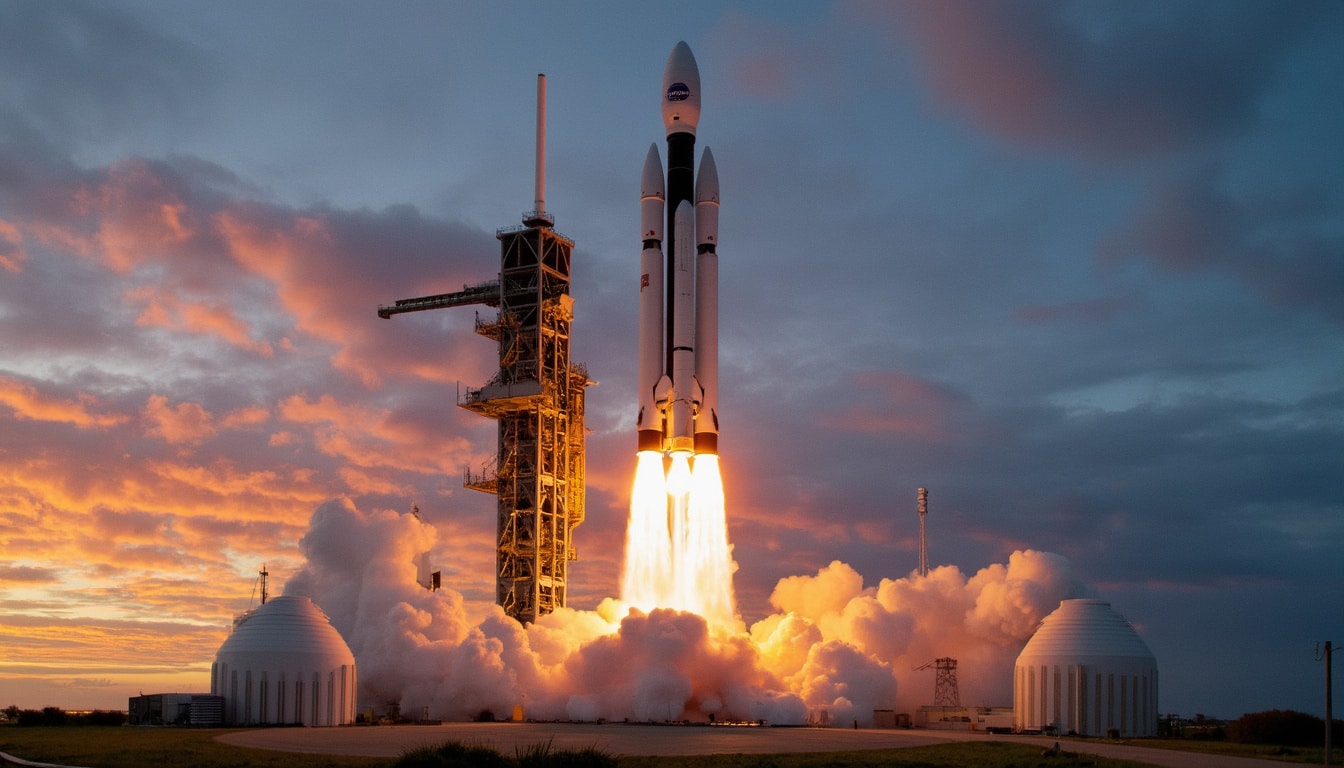The National Reconnaissance Office (NRO) is rapidly transforming the landscape of aerial surveillance and intelligence gathering through a series of groundbreaking satellite launches by SpaceX. Recent missions, including the deployment of NROL-69 and NROL-57, have set the stage for the expansion of the largest-ever U.S. government satellite network. These advancements not only signify a technological leap but also a pivotal shift in how the U.S. approaches national security through satellites and defense strategies. With the NRO’s ambitious plans and SpaceX’s cutting-edge launch services, the future looks promising for intelligence capabilities.
The recent launches from Cape Canaveral and Vandenberg Space Force Base mark the beginning of a new era for surveillance technology. As the NRO continues to enhance its satellite constellation, reliance on advanced technologies for communication and surveillance becomes more critical. Each deployment serves to bolster the United States’ military operations, solidifying the NRO’s position as a leader in aerospace intelligence. As part of an ongoing commitment to innovation, the partnership between SpaceX and the NRO highlights the transformative potential of modern space exploration.
The Significance of the NROL Missions
On March 24, 2025, a Falcon 9 rocket successfully lifted off to deploy the classified NROL-69 mission for the NRO, marking a pivotal moment in the expansion of U.S. satellite capabilities. This launch is notable as it represents the first National Security Space Launch (NSSL) mission of 2025 and showcases the NRO’s enduring collaboration with SpaceX, especially under the new NSSL Phase 2 contract awarded by the U.S. Space Force.

Momentum Building Towards Expansion
Following the rapid succession of launches, the NROL-57 mission took place just days earlier, on March 21, 2025. It emphasizes the increasing pace at which the NRO intends to build and deploy this new satellite architecture. The initiative to launch over 150 satellites in recent years is a clear indication of the NRO’s commitment to creating a surveillance system that stays ahead of global rivals.
The NRO expressed in a statement that 2025 will be a dynamic year, with around a dozen planned launches designed to expand this proliferated satellite network further. This initiative demonstrates how essential it is for the agency to modernize and maintain an edge over adversaries in the field of intelligence-gathering from space.
Strategic Partnerships and Technological Innovations
The integration of modern technologies and methodologies represents a paradigm shift for defense and intelligence communities. The partnership between SpaceX and the NRO relies on mutual cooperation to leverage SpaceX’s advanced launch services and Northrop Grumman’s satellite construction capabilities. By combining strengths, these organizations have established a satellite network that significantly enhances situational awareness for U.S. military operations.
This collaborative effort also demonstrates a pressing demand for innovative solutions in military operations worldwide. As geopolitical tensions rise, ensuring secure and reliable surveillance capabilities becomes paramount. The rapid deployments of small satellites into orbit not only expand coverage but also allow for real-time intelligence gathering.
The Future of Intelligence Surveillance
The NRO’s vision stretches beyond immediate launches; it includes a dedicated roadmap for extensive deployments extending through 2029. This long-term commitment to growing its satellite constellation indicates the desire to cultivate superior intelligence capabilities. The integration of advanced imaging technology will not only facilitate military operations but also provide a comprehensive understanding of various global situations.
| Mission Name | Launch Date | Agency | Purpose |
|---|---|---|---|
| NROL-69 | March 24, 2025 | NRO | Expand satellite network capabilities |
| NROL-57 | March 21, 2025 | NRO | Support proliferated satellite architecture |
The advancements in satellite technology stand to redefine how the U.S. gathers intelligence from orbit. As the NRO establishes itself as a pivotal component in defense strategies, the importance of surveillance capabilities becomes ever more critical. The commitment to frequent satellite launches cements the U.S. position at the forefront of global intelligence operations.
A Closer Look at the National Reconnaissance Office
The National Reconnaissance Office, tasked with designing and operating U.S. government satellites, plays a crucial role in national defense. Historically, the agency has focused on creating and maintaining a secure and classified environment for surveillance activities. It ensures that critical information is gathered for military and civilian leaders alike.
Missions and Goals of the NRO
The NRO operates in close consultation with the Department of Defense and various intelligence agencies. It has been increasingly proactive over the last several years in expanding its surveillance capabilities. The aims include gathering intelligence and providing insights crucial for decision-making at multiple levels within the government.
Each mission not only contributes to broader defense objectives but also aims to enhance overall capability across various challenges, including advanced reconnaissance and threat assessment. The NRO’s vision focuses on ensuring that the United States remains a step ahead through superior satellite capabilities and technology.
Challenges Ahead
While the recent success of these missions represents a significant step forward, challenges remain within the backdrop of modern conflict. The rise of other nations improving their surveillance systems means the NRO must adapt continuously and redefine its strategies. Protecting the integrity and security of U.S. assets in space is paramount.
As global dynamics shift, collaboration between various stakeholders within the aerospace sector becomes vital. Only by working together can agencies ensure resilience against any potential threats posed by competitors in the field of satellite and defense technologies.
The Role of Innovation
Innovation is at the heart of the NRO’s incredible journey over recent years. By investing in emerging technologies such as artificial intelligence, machine learning, and autonomous systems, the agency can maximize the efficacy and efficiency of satellite operations. These innovations not only foster accuracy but also streamline intelligence-gathering processes.
It is evident that SpaceX’s innovative approach to launch services and rapid satellite deployment synergizes well with the NRO’s goals. Such partnerships pave the way for a robust defense infrastructure that can promptly adapt to an ever-evolving geopolitical landscape.

The Implications for U.S. National Security
The implications of these satellite deployments have reverberating effects on U.S. national security. As the NRO amplifies its capabilities, the ability to monitor global developments will become increasingly robust. Intelligence acquired from satellite systems is crucial for timely decision-making and maintaining strategic advantages on a global scale.
Proactive National Defense Strategies
The NRO’s active approach toward satellite deployment signifies a shift toward proactive strategies in national defense. Traditionally, agencies have relied on reactive capabilities to monitor threats. However, with the expanded surveillance framework, anticipatory measures can be enacted, safeguarding national interests.
Coverage over critical areas around the globe will empower teams to assess situations in real-time and adjust strategies as required. The impact of a well-orchestrated surveillance system becomes integral to ensuring security across key theaters.
Changing the Landscape of Intelligence Gathering
Such advancements in surveillance capabilities will likely affect U.S. foreign policy conversations. The trend towards enhanced intelligence-gathering compels government bodies to operate with more foresight. Leaders will rely heavily on accurate real-time data to inform policy decisions and defense strategies.
Positively influenced by the reliable satellite system, U.S. military and governmental agencies can maintain a comprehensive overview of potential threats. This leads to timely and informed decision-making, reinforcing national security interests on multiple fronts.
Global Relations and Competitiveness
The NRO’s efforts must also factor in the spectrum of global relations and competitiveness. As other nations ramp up their surveillance capabilities, the U.S. must remain vigilant. A well-structured NRO satellite network ensures that the country remains a relevant player in international relations, asserting influence through technological superiority.
Failing to sustain this momentum may lead to disparities that could threaten the balance of power. Therefore, as the NRO enhances its capabilities, it simultaneously reinforces the importance of international collaborations, alliances, and diplomatic engagements to sustain peace and security worldwide.




Leave a Reply